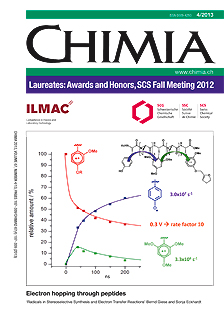1,2,3-Triazoles as Amide-bond Surrogates in Peptidomimetics
DOI:
https://doi.org/10.2533/chimia.2013.262Keywords:
Amide mimics, Click chemistry, Cuaac, Peptidomimetics, 1,2,3 triazolesAbstract
1,2,3-Triazoles represent a class of heterocycles with interesting properties for application in peptide sciences since they closely resemble amide bonds while being stable to enzymatic degradation. These characteristics make 1,2,3-triazoles promising candidates as amide-bond surrogates for the development of novel peptidomimetics with potentially improved biological characteristics. Despite the potential of the heterocycle as an amide-bond isoster, only few examples of triazole-based peptidomimetics can be found in the literature. With the intention to promote this new and promising strategy for peptide modification, this review summarizes synthetic methods available for the facile preparation of ?-amino acid and ?-amino alkyne building blocks and their use for the incorporation of 1,4-disubstituted 1,2,3 triazoles into the backbone of peptides mediated by the Cu(i)-catalyzed alkyne–azide cycloaddition (CuAAC). In addition, examples of the successful amide-to-triazole substitution in biologically active peptides are presented.Downloads
Published
2013-04-24
Issue
Section
Scientific Articles
License
Copyright (c) 2013 Swiss Chemical Society

This work is licensed under a Creative Commons Attribution-NonCommercial 4.0 International License.
How to Cite
[1]
I. E. Valverde, T. L. Mindt, Chimia 2013, 67, 262, DOI: 10.2533/chimia.2013.262.







